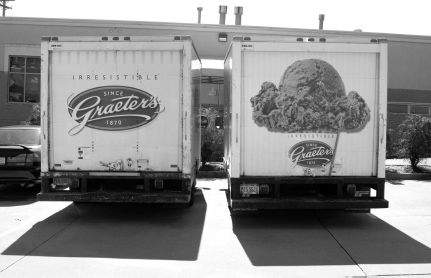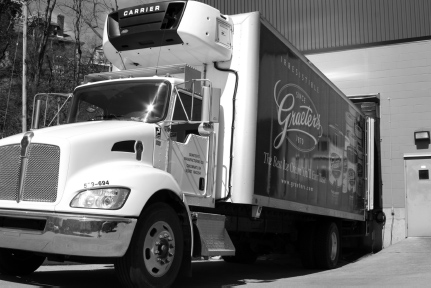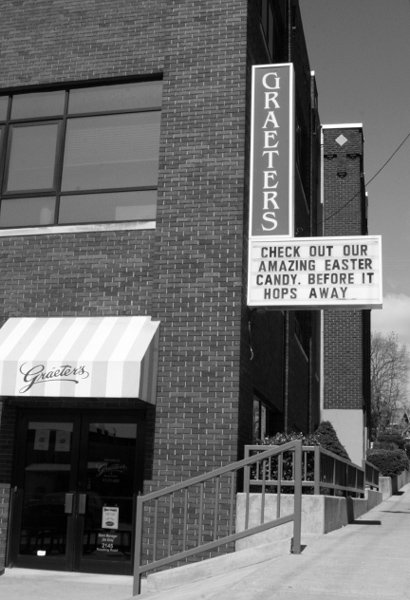Greater's Ice Cream (9 page)
Read Greater's Ice Cream Online
Authors: Robin Davis Heigel
Tags: #Graeter’s Ice Cream: An Irresistible History

Nonetheless, he quit his job as a flight attendant and took over managing the Fourth Street store downtown in the summer of 1989. It wasn't what he expected. “I hated what I was doing. I absolutely hated it,” he said, candidly. “Going from carefree, just having fun, having a blast, something different every day to all of a sudden getting there at 6:00 a.m. every day to 5:00 or 6:00 at night, every single day, Monday through Saturday.”
But he muddled through one year, married his college sweetheart and began to settle into the family business.
HE
F
IRST
E
XPANSION
In 1994, the company decided that it needed to expand the plant facility on Reading Road to accommodate the expanding business into grocery stores.
“I had architects and an engineering firm working on a building in 1990 knowing we needed to expand because we couldn't really handle our business,” Dick said. “But Richard didn't feel we were doing well enough to be able to afford to build a building. So we started this addition in '94. Moved here in '95.”
The expansion doubled the size of the plant. They added dry storage on the second floor that gave them space to expand the candy room. They doubled the size of the ice cream room and built a freezer five times bigger than the one they had. They added a retail store to the space and expanded the dock area so trucks could actually back in and load up the product directly from the plant.
“We borrowed a lot of money at the time. We went through years and years and didn't borrow any money for equipment or anything. Finally, we did,” Dick said. “We borrowed better than
a million dollars. At that time for us, that was a lot. [Richard] helped do it. We had to do it. If we were going to be in business, we had to do something. We were busting at the seams.”

The factory on Reading Road originally did not have a loading dock for trucks such as these.
Courtesy of Ken Heigel
.

An expansion of the factory on Reading Road in 1994 included the addition of a loading dock.
Courtesy of Ken Heigel
.

The expansion of the factory on Reading Road in 1994 included the addition of a store that sells ice cream, baked goods and chocolates.
Courtesy of Ken Heigel
.
Roughly the same time, Chip's role expanded. He took over the company's number-one grossing store in Kenwood and then worked at bringing in and training good people who could work as district managers, each handling four stores.
“We hired and trained and developed systems and processes. That's kind of where that went for the next couple of years really,” he said. “Then in 2001, 2002, we went through that transition.”
AKING THE
M
OVE
The actual transition of ownership between the generations proved one of the hardest endeavors the family undertook. Part of the problem was figuring out how to equitably sell and gift the ownership of Lou, Dick and Kathy to Richard, Bob and Chip. Richard was Dick's son, Bob and Chip were Lou's sons and Kathy had no children. Plus, Dick and Lou were ready to retire, but Kathy was not.
In an interview with
Business Courier
in 2004, Dick said, “We always felt, starting up in this process, that the only way ultimately it would work was to do it a third, a third, a third. It was very difficult to get my son, who was entitled to half at the time, to agree to that. That was a big problem.”
The differences of opinions between one another and the generations on day-to-day operationsâwhat time the stores should open, whether they should buy a new truck, for exampleâcaused conflict, too.
“Transition is always a struggle,” Kathy said. “You always have to be thinking ahead to how the future generation is
going to fit in.” The family began to realize that a successful past didn't guarantee a successful future.
After months of discussing the transition plans with no success, Richard finally offered an ultimatum: get outside help or he would quit the business altogether. And by help, Richard didn't mean more consultants or lawyers. He wanted a family business psychologist.
The Graeters agreed and selected business psychologist Michael Harting at the University of Cincinnati's Goering Center for Family and Private Business to help iron out the plans and work with the feuding personalities. Hartings worked with the family for almost three years, individually and as a group.
The biggest problem, Hartings said in the interview with the
Business Courier
, was that the Graeters lacked a cohesive vision for the future. In addition, they each carried their own issues with the family history.
One thing Hartings emphasized was that the fourth generation had to take a step back from the day-to-day issues and focus on long-term visions for the company. In an interview with
Smart Business
, Richard said the consultants they hired to assist in the transition told them, “If you are out there driving and loading trucks and making ice cream, you can't possibly plan where you want the business to go five or ten years down the road because you're worried about the next five or ten minutes.”
The new generation would have to take a broader approach.
At one point, the family divisions looked so cavernous, so impassable, that the family considered splitting the company up, giving Richard the franchises and Bob and Chip the corporation. Ultimately, it wasn't what the family wanted, so they continued to work through their differences. A grave family illness hastened the plan.
Since 2000, Dick had been successfully battling esophageal cancer. But in July 2003, fluid began to build up around his
heart. A complication during surgery to drain the fluid caused a serious infection in Dick's lungs. He spent days in intensive care, and for a time, it wasn't clear he would survive. “That made us see how impermanent life is,” Richard said.
Upon his recovery, the family was able to put aside its impasses and find suitable solutions to their problems.
On December 31, 2003, the transfer of ownership was completed. It would be a new era for Graeter's Ice Cream. When the official legal transition was complete, the third generation had to decide on their new roles. Kathy wasn't ready to retire, so she stayed on to help Chip with the retail business. Lou officially retired but still comes in early every day to help load the trucks with freshly baked goodies to deliver to the stores.
At the beginning, Dick came in every day, too, to offer his opinions and guidance, but it became a source of conflict. “Finally, after two months, I said to him, âDad, as long as you are here every day, Chip, Bob and I will never be able to run this place,'” Richard said. “âYes, we may make mistakes, but we need to make them, learn and move on.'”
Dick agreed and finally fully relinquished his control. Everyone agrees that the process was painful, but the outcome was what they wanted.
“We were smart enough to see we needed outside help,” Chip said. “Our fathers worked seventy hours a week in the business, but they didn't set up any kind of transition plan.”
Like the third generation before them, the new owners' roles worked out naturally. All three are equal partners: Richard became the CEO, while Chip became the vice-president of retail operations and Bob became the vice-president of production.
Bob and Chip were both happy to relinquish the CEO role to Richard. “Bob and I certainly didn't want it,” Chip said of the CEO position. “Rich was an accountant in college, then he got a law degree. He kind of knew what he wanted to do.
Rich's personality is such he's fairly driven in that realm. Rich is much more gregarious and loves that role much more than either of us would.”
Chip was happy with his role of heading up the stores.
I always knew I would be in retail. That's where I wanted to be. It had grown on me. I'm very comfortable running our fourteen stores, making sure they're looking good. I'm very focused.
My brother had been in sourcing ingredients and production and a lot of that, taking care of formulations and processes. He is so happy doing what he does. He doesn't want to be out there.
So we all kind of had a niche. It was really a matter of how we would divide the business up.
And all three believe the family is stronger because of the struggles they went through to get to this point. “Today I think we're better than we've ever been. We're together and we're moving forward,” Richard said. “Everyone has a piece to contribute. That's really important. We respect each other and trust each other. And like each other. We couldn't say that ten years ago.”
Chip agrees. “We traversed through that tumultuous time. But all in all it made us all stronger,” he said. “It made us more thankful for each other, eventually. I mean it was terrible at the time. It wasn't really fun. But it was something we had to do.”
The benefits now, they all say, are how close the family is and how great it can be to work together. Chip, for example, loves seeing his father and his aunt Kathy every day. Richard said that he and his sister, together with their families, still have Sunday dinner every week with their mom and dad.
EW
L
OOK
, N
EW
I
DEAS
Once the transition of ownership was complete and the roles were defined, the three new owners had to decide what they wanted to do and where they wanted to take the company.
One of the tasks was deciding how Graeter's should appear to the public. “The first thing we did was work on our brand. That was something the three of us all did together,” Chip said. “And it was an awesome experience. Something I'd never done before.”
While the Graeter's name was well known, the logo itself wasn't necessarily. When the fourth generation took over, the brand logo appeared several different ways in the stores and on products. Over the years, a consistent brand look hadn't been important because the family had been so concerned with the day-to-day operations.
To consolidate the look into one consistent appearance, the company employed Libby Perszyk Kathman Inc., an international brand design agency located in Cincinnati. The company took components from the different logos and created one streamlined version that it incorporated into new packaging. The Graeter's name remained in script typeface, but the pink letters and stripes on a white background were replaced with pale yellows and rich mahoganies, colors that were also used in the development of new stores.
“There is a big difference between [a logo] that has been well thought out and executed and one that has been done on the side, as a secondary product or project over a hundred years. That's what we had. We haven't had a real brand other than the quality of the product,” Richard said in an interview with
Smart Business
in 2005.
They also relaunched their website,
graeters.com
, with the new look and brandingâand the ability for customers
from around the country to order ice cream and gift certificates online.
